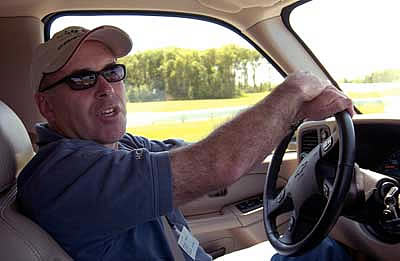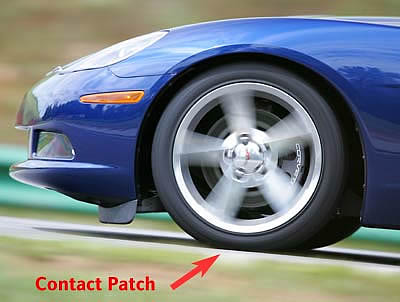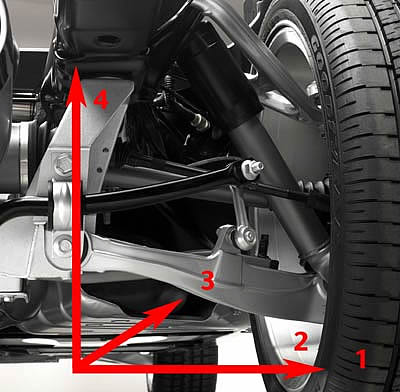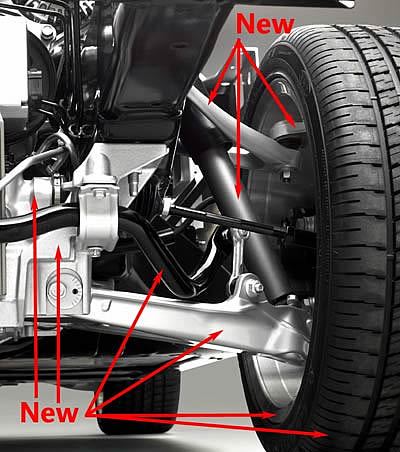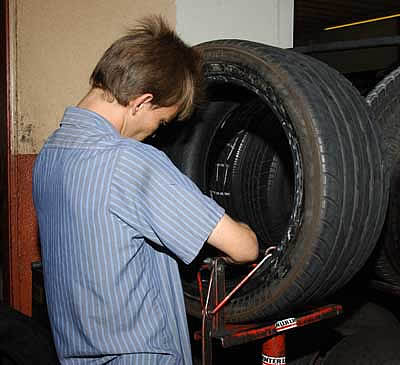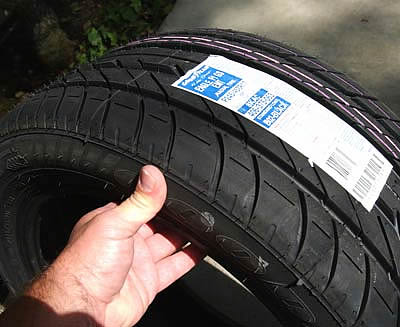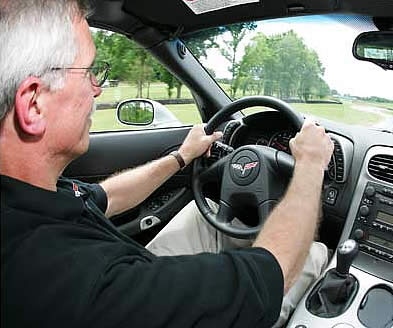C6, Naked and Exposed: Corvette Action Center's First Look at the 2005 Corvette - The Sequel: Finally, We Drive It! - Page 9 of 12
 |
 |
C6 Naked and Exposed - The Sequel: Finally...We Drive It!!! - Page 9 of 12
And, Talk to Some of the People who Built It
by Hib Halverson
Imagery by GM Communications, Richard Prince, U.S. Air Force and Sharkcom
©2005 Shark Communications
No use without permission
Ride and Handling
C6's exterior is a pleasing blend of contemporary and classic interpretations of America's Sports Car and the LS2 is unprecedented in Corvette history for its 400 horsepower and 400 pound-feet torque, but good looks and lots of power are only two elements needed to make a benchmark, performance car. The other part is a chassis which handles well, rides nicely and stops quickly. The C6 structure evolved from that of the already-good C5. For 2005 it was enhanced with a few changes detailed in text and images in C6, Naked and Exposed: Corvette Action Center's First Look at the 2005 Corvette. There also were changes in suspension and they payoff in a reduction in road noise, an improvement in ride and an upgrade in the Corvette's already great handling.
What were the ride-and-handling goals for C6? For that we spoke to an old friend of the Corvette Action Center, Mike Neal, Corvette's ride-and-handling Development Engineer. We talked to Mike at the Milford Proving Ground where the June 4th media event concluded and, also, in a later telephone interview.
"Everything with the C6 starts with the C5," Mike Neal states. "You say, 'Ok. What do we like? What could we improve on? What takes an architecture change to improve something we couldn't on C5?' We wanted to improve ride. We wanted to decrease noise. We wanted to improve handling."
Ending up with a better Corvette in those three areas required a lot of redesign work and development time, particularly the efforts at noise reduction and with the third-generation, Goodyear run-flat tire. We covered C6's body-related, acoustic improvement earlier. Now, let's look at noise work on the chassis side and virtually all of that was in the new Goodyear tires, the F1 GS-2 EMT and the F1 Supercar EMT.
From an acoustic perspective, the two key differences between the third generation EMT architecture and C5's 2nd generation run-flats are: 1) a tread configuration less capable of generating noise and 2) a tire shoulder less capable of transferring noise.
"You have parts of the tire at the contact patch which are excited at frequencies in the audible range," Neal continued, "and then, you have a transmission path from the contact patch, around the shoulder, up through the sidewall, into the rim, through the suspension, through the vehicle structure and into the interior."
"Goodyear made some changes at the contact patch to minimize those excitation forces. Then, between the contact patch and the sidewall, they added-in noise and vibration terms-a "decoupler," which provides a point of isolation which breaks the noise transmission path."
In addition, we talked to two Goodyear Engineering Managers, Larry Jansen and Nick Hill (no relation to Corvette Chief Engineer, David Hill), who each led Goodyear's tire development program at different times. "There are two sources of noise in a tire," Jansen told the Corvette Action Center. "The first is tread noise. This tends to be airborne, getting to the driver's ear through the air, rather than through the vehicle structure. There are ways to manage that noise energy. First, we reduce it overall and, second, we try to eliminate peaks, because you notice peaks. You don't notice an overall 'white noise' as much. We made changes to the tread pattern which reduce that noise."
"The second is structureborne noise, which initiates either at the tread or as a bump resonance or impact resonance. What Mike's talking about with that 'isolation' or the 'decoupler' was the structureborne noise originating in the tread. We try to damp it as much as possible and, also, deny it a good, clear transmission path by isolating the tread acoustically from the sidewall. If we don't pass much of it to the carcass, then it won't get though the wheel into the suspension and into the car."
"Bumps or impacts may resonate in the cavity-the space inside the tire," Jansen continued. "The cavity's resonant frequency depends on tire size. We try to make sure whatever that frequency is, there is no good transmission path for it to the suspension.
"Because we're talking about an EMT with sidewall inserts (structure built into the tire casing which provides most of the support during run-flat operation), it's a more rigid side wall, which transmits more resonance, so you have to work very hard at noise reduction. We did a lot of analysis and we made some changes both to the construction of the tires, which affects the cavity resonance and its damping, and made additional changes to the tread pattern to reduce that noise."
In the mid-'90s, when the C5 run-flats were designed, technology didn't exist to do the above. For C6, scores of prototype tires were submitted by tire companies-Goodyear, alone, submitted about 15 designs-to GM for evaluation in a tire design, development and validation process that took a three long years.
"A lot of the noise issues depend on the interaction of the tire with the vehicle," Goodyear's Nick Hill said, "but no matter what we do with the tire, the final check is always to see if any of the (sound) peaks coincide with any of the vehicle's natural frequencies, so no matter how much we do in the lab; the acid test is really on the vehicle."
"That meant we had to a lot of different constructions, get Mike to ride them, get the GM noise guys to measure the results and tell us whether we made an improvement or whether there was a peak somewhere that they didn't like or wanted to get rid of. Certainly, with the FE1 (the base level F1 GS-2 EMT), the majority of the early development was concentrated on getting the noise as low as possible. That led to a lot of submissions of different constructions."
Another key goal was improving the car's ride but doing it in a manner that did not detrimentally affect handling. Fortunately, since the basic Corvette suspension architecture is good at decoupling ride from handling; it was possible to achieve some pretty substantial ride gains while, also, improving handling.
Mike Neal: What did we do to improve ride over C5? Two main things. First, we increased the ride travel, particularly in the rear. That drove a whole new set of parts. Even though they very similar to what's on C5, we couldn't get the desired improvement without redesigning the parts.
CAC: Get an '05 up on a lift, stand back and look and it seems little has changed. Start looking closely or, even better, have a C5 nearby with which to compare and you quickly see much has changed.
MN: That's exactly right. They are significant changes. To get greater ride travel, we had to change the control arms, knuckles and shocks.
Secondly-and now it's back to tires-there were things Goodyear learned with run flats and things we were doing (to the chassis) which made those things work even better. Goodyear developed technology that made a softer tire that was still durable at zero air pressure.
CAC: Is the durability spec for run flats still the same?
MN: No. We changed from 200 miles to 100 miles. With C5, we learned what our customers needed: the ability to get out of the (low or no tire pressure) situation they're in and conveniently get to a Goodyear dealer.
So how many miles is that? C5 was the first car ever without a spare tire. Back then (mid-'90s, during the C5 development), we discussed whether we wanted to be 100 miles or 200 miles. At one point, we were at 100 miles, but we were able to test to 200 miles. Goodyear was achieving, ah-overachieving-so we said, 'Well 200 is a good place to start because we just don't know where people will feel uncomfortable.'
With C6, we said, 'Ok. We've had a generation on run flats and we think we're giving people at least the mileage they need to get to a Goodyear store. We thought that 100 miles was a more optimum number. That allowed Goodyear to soften the tire compared to C5.
Nick Hill: As you know, that 100 miles is very worst-case, with the vehicle fully loaded and the valve core out. In reality, customers are going to get better than that. I think GM really felt that 200 miles, worst-case, was more than was needed.
To get more comfort and softness into the car by reducing that target, was the direction they wanted to go.
Larry Jansen: And, again, as you remember, in the beginning, we wanted to be absolutely iron-clad-sure that nobody ever got stranded. Back in the mid-'90s, (when the second generation run-flat, the F1GS EMT, was under development for C5) in order to say that the tire would go 200 miles under any circumstances; we were testing tires at St. Angelo (Goodyear's proving ground in Texas) and they were failing at like 450-550 miles. So the 200-mile spec. was extremely conservative and robust.
CAC: I recall some of our very early discussions about run-flats touched on that issue.
LJ: Yeah, they did. But now, as we've had eight years of field experience and know what customer experience has been; there are more advantages in reducing the mileage than there is a penalty. By getting down to some more realistic level, we're able to give a lot better performance in other areas.
CAC: When you changed the run-flat spec to 100, how did you arrive at that number? Were the most distant Goodyear dealers 100 miles apart?
MN: Think about this country. How far are you from civilization? Is there some place down in, say, New Mexico between Tucumcari and Albuquerque, where you can find yourself stranded? How close are you to a major city? That was what drove it, rather than dealer locations.
CAC: Who made the call on reducing the run-flat distance from 200 to 100. Was General Motors or Goodyear?
LJ: I'm going to say it was a joint decision.
CAC: You're on Interstate 70, going through Utah. Between Green River and Salina, it's 105 miles and there's nothing except rest areas.
MN: So your only 52 and a half miles from either. And, that 100 miles is at gross weight, 55 miles an hour, 70 deg. ambient temperature with a hole in the tire, in other words: no ability to contain pressure at all.
That last point is huge. Eighty-five percent of our tires are slow-leakers. If you've got some air captured, even at zero pressure, the moment you start driving; you'll build two or three psi with temperature. That air volume is contained. It's not pumping in and out of a gigantic hole. That greatly increases your distance, but we do all of our testing-the 100-mile rating-to the absolute worst case.
CAC: Does the 3rd generation run-flat still have the ability to be repaired if it goes 50 miles or less?
NH: Yes. The repair policy is the same for C6 tires as it was for the C5.
CAC: If it's a slow leak, say a nail or a screw in the tread, as long the tire is not run flat to point of destruction; you can repair it and put it back on the road. Correct?
NH: Well, yes, but I'd qualify that statement. It can be repaired but the tire, first, needs to be inspected by a Goodyear technician who checks that no structural damage has been done to the tire while it was run flat. The technician does that by inspecting the inside of the tire and determining how much heat build up there has been. If the structural integrity of the tire's carcass has been compromised, the puncture cannot be repaired.
MN: Now, on the car side, with active handling being standard, whenever you have a flat, active handling comes in and...
CAC: Yeah. We covered this before-the more aggressive, safety-oriented algorithms which are enabled if the low tire pressure warning system detects low or no air pressure. (See C6, Naked and Exposed: Corvette Action Center's First Look at the 2005 Corvette)
MN: Exactly. With all of those things we were able to do a much, much softer tire which is better for ride.
Handling upgrades often come at the expense of, or at least with a compromise in, ride; however, the unique situation presented in Goodyear's redesign of the EMTs allowed Mike Neal to make an improvement in handling at no expense to, and in fact, in conjunction with, improvements in ride and noise.
A certain amount of compliance in the tire casing enhances the action of the suspension. The second generation EMT was not very compliant and could not play that role in C5's handling and, actually, it's stiffness was a ride and noise problem Neal and others had to work around. With both third generation EMT's, Goodyear made several major changes that resulted in a more compliant tire casing, a quieter tread pattern and a mold shape which resulted in a more optimum shoulder and crown.
MN: I never take a tire off the shelf. We do a lot of development and testing with all the tire companies. Goodyear continues to supply a superior product and we always use a unique tire for our chassis. There's a big advantage to Corvette when we can design a tire for our chassis.
The four tire properties key to handling are: mold shape-that has everything to do with the footprint when it's loaded in a corner. Goodyear worked with mold shape on C5 and further developed that on C6, specifically, to get a better contact patch when the tire was dynamically loaded in a corner.
The second one: construction. That's everything affecting crown and sidewall stiffness, like: belt angles, turn-up lengths, direction of the plies, angle of the plies, different materials we use in different areas, apex and under-tread gauge-thickness. There are dozens of items which Goodyear and I can play with.
Third item: tread pattern-that's obvious. Goodyear did lots of stuff with tread pattern. Not only for wet traction and snow traction, like you would think, but for dry traction, too-how those blocks squirm and move around and are supported in a corner or in a fore-aft direction. How they wear-are they wearing evenly-not only for normal driving, but on the track, too?
We had Goodyear make specific mold changes to alter the tread pattern in the most minute way-you couldn't hardly tell, unless you knew what to look for-to make sure that they would wear evenly on the track. Crowning certain tread blocks, adjusting the grooves between the tread blocks so that you can support the tread as it moves and squirms around. Putting certain angles on the grooves to, again, better support the block. This gets very, very detailed.
The fourth thing is compound and we have two different ones, now, for the FE1 tire (base and F55 cars) and the FE3 tire (F1 Supercar EMT for Z51s).
Another obvious C6 tire feature is different sizes, P245/40ZR18 and P285/35ZR19. They are on wheels an inch larger in diameter and the rears are half-an-inch wider. The overall tire diameters are similar to C5 and the width in the front is similar, but the rears are about 10mm wider. The bigger rears help the car get LS2's extra torque to the ground.
Goodyear was, also, able to reduce tire weight. "We wanted a run-flat tire which was more transparent, that is, improve the ride and reduce the unsprung mass to be closer to what a non-run-flat would be," states Larry Jansen.
"With the C6 tires, the fronts are 0.92 kilogram lighter but the rears are 0.4-Kg heavier than C5's EMTs," Nick Hill added. "Efforts at mass reduction paid-off better than the numbers look. A major objective of the tire development was to keep the mass to a minimum and this was achieved mainly by using lighter sidewall insert materials.
"Noise from the rear of the car became a big issue. While GM gave us targets for mass, rolling resistance and various other things, they came back and said, 'Yeah those were the targets, but now noise is the most important thing. Do whatever you need to do to lessen the noise.'
"The particular frequency they had an issue with was an 800 Hz peak (at the low-end of the frequency range of speech) and they were so keen to get rid of it that we did a number of different constructions with all the things we thought would affect it.
"One thing attenuates noise, sometimes, is adding extra mass under the tread," Nick Hill continued. "We had eight or nine different rear tire constructions and the one that came out the quietest was one of the heavier versions. GM knew it was heavier than their target, but they said, 'Well it's important that we get the noise reduction.'
"In the sidewall, where the run-flat part of the tire is being controlled, there are new materials which are lighter, stronger and more heat-resistant. If you were to do a C5-sized EMT but with that new technology, you would have a considerably lighter tire. With the C6 rear tire, other things got put back in that made it heavier, plus, it is, also, a bigger tire. I think that's why some of those numbers might be a little deceiving."
The spring rates on a C6 have not changed much. Mike Neal looks at the bigger picture of "ride frequency", a function of wheel rate (a combination of spring rate, antiroll bar rate, bushing rates and tire rate) and vehicle mass. The C6 has the same ride frequencies as the C5.
The 2005 Corvette does have more roll stiffness via larger diameter antiroll bars. With the improvements in ride and a better tire which offered much more grip, Neal increased bar rates to gain lateral acceleration. Interestingly, because of higher lateral acceleration, the actual body roll a C6 demonstrates is about the same as C5, even though the bars are bigger.
One key suspension improvement which has to do with handling, but not necessarily the at-limit variety, is a one degree increase in front caster. The C5 was already at the caster adjustment limit, so the only way to get more was redesign the front suspension cross member, control arms and steering gear. More caster increased straight line stability and decreased the front end's tendency to wander left or right when the front tires are in "troughs" in the road surface. Troughs are caused by constant heavy truck traffic on asphalt roads or, on concrete roads, joints, parallel to the direction of travel between uneven slabs of road surface.
All the front control arm bushings were changed. The lowers have a higher axial rate for improved durability, but their radial rate is unchanged, so ride is not affected. The manufacturing process used to make the uppers was changed to improve durability.
At the rear of the chassis, to better damp powertrain movement, two hydraulic transaxle mounts are used instead of the C5's single mount. Also, the rear spring was relocated to above the control arms. These two changes required a redesign of the rear suspension cradle and the rear control arms.
CAC: What about damping, 2004 vs. 2005?
MN: What you'll feel as you go around the MRC ("Milford Road Course"-more on that later) or Grattan (a race track in western MI) or any other place that has vertical road content- undulations and roughness-is better body response. The body is not being shoved around as much as C5. It's a smoother, more flowing body motion.
CAC: So where did you change damping rates?
MN: It's kinda tough to tell you exactly where that is, but let me think about that for a minute...
While Neal is considering our question, we'll tell you that of all the suspension tuning craft, damping is the most complex part. It involves a head-spinning amount of variables that are addressed with technology, knowledge, experience and a healthy dose of black art.
While Mike doesn't specifically address the C6 version of Magnetic Selective Ride Control (F55), generally, the calibration of "MagnaRide" or, just "MR," was altered to provide the same results as do the changes in shock valving for '05's with hydraulic dampers. In addition, since MR for '05 uses a new, faster Siemens controller, the calibration was revised to reflect that. Otherwise, MR is very similar to the '03-'04 version of the system profiled in another Corvette Action Center article: Magnetic Ride - Star Wars Meets the 50th Car.
Even with the length of our follow-up C6 coverage, it really isn't possible to cover everything that changed as far as shock absorbers, so what Mike did was give us an insight to one part of the task.
MN: On the C5, I had to do some things to catch the car as it would get sprung out of the jounce bumper. It was as if I had to tune the shock around a stiffer spring rate because the tire was stiffer, that meant less of the bump (on the road) was being enveloped with the tire and the suspension was being forced to travel more. A lot of times that would put it into the jounce bumper. As soon as you hit the bumper; you had an entirely different spring rate to damp against. Valving shocks for that was difficult.
With C6, because so many other things in the chassis changed-the tire got softer and I had more ride travel-with the tire softer and more enveloping; I'm forcing the suspension to travel less, and it's a suspension which has more travel to begin with. So, now, the jounce bumper is rarely in play and I could optimize the shock valving around the basic chassis components: tire and spring rates, and not have to consider the jounce bumper rate as much.
There's a lot of other damping issues like that which are too difficult and too time consuming to tell you about on the phone.
CAC: Basically, there is quite a bit different in the shock valving.
MN: Correct. To take advantage of those things I just mentioned: the more enveloping tire, greater ride travel and not having to deal with the damping against the jounce bumper rate.
The end result of this is a C6 suspension that handles better and is vastly improved in ride.
 |
 |
